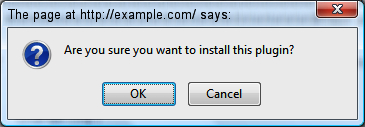Once again, there are different ways to go about adding plugins to your site and the method that you need to use will depend upon which plugin you would like to install.
Plugins found in the WordPress Plugin Directory, which is located at http://wordpress.org/extend/plugins/, can quite easily be added to WordPress on the Install Plugins screen. To reach this screen, click Plugins | Add New. On this page, you can search for plugins by keyword, author, or tag. In addition, you can also click the Featured, Popular, Newest, and Recently Updated links to browse though the plugins found there.

Once you've located a plugin that you would like to add to your site, click Install Now. When the pop-up box appears to ask you if you're sure that you want to install the plugin, click OK. WordPress will then work to install the plugin on your site. Once it's finished, you will be presented with an installation results page. On this page, click Activate Plugin.
If you would like to use a plugin on your site that can't be found in the WordPress Plugin Directory (because it's either a premium plugin, or because the developer hasn't submitted it for inclusion), then you will have to use a different method to add it to your site.
In that case, the plugin must be uploaded before WordPress can install it. To do this, click on Plugins | Add New. Next, click the Upload link found near the top of the Install Plugins screen. Now, browse your computer to find the ZIP file that contains the plugin that you would like to add to your site. After you've located and then selected the file, click Install Now. WordPress will then work to install your chosen plugin. When you arrive at the installation results screen, click Activate Plugin.
Note
As was the case with themes, if the plugin that you want like to add to your site isn't in a ZIP file, then you need to go about things a bit differently. In this instance, you need to use either an FTP program, or the file manager provided by your web host, to upload the plugin's folder to the wp-content/plugins directory on your server. Once the plugin has been uploaded, visit the Plugins screen to activate it on your site.



